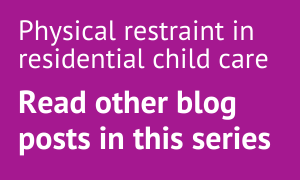There's no place for physical restraint in residential child care
Alex Horne is a Participation Assistant with South Ayrshire Champions Board and is care experienced.

There’s no place for physical restraint in residential child care in the 21st century – there, I’ve said it, put it out there! I advocate for a total ban on restraining young people, and I would start it right now if I could.
When a young person acts up or shows signs of distress, there are lots of other ways that carers can de-escalate the situation, calm down the young person, and let them feel ‘heard’. Violence is not the answer.
For me it all starts with trust, and that is built through respectful relationships, and through two-way conversations. It’s important residential child care workers get to know the young people in their care, find out what could be bothering them, and what their emotional triggers are, so that they very seldom reach crisis point, and if they do, what will calm them down.
Finding out the hard way
I speak from experience - I spent several years in a residential school, and was restrained every day I was there. If I tried to walk out of class because I didn’t want to be there – I was restrained, if I showed emotion – I was restrained. After every restraint, when I had calmed down, I was then made to apologise for kicking off and explain why I had, before I was left alone. There was little thought given to my emotional wellbeing and how this affected me.
I remember one day in the residential house I was watching football with a member of staff, when another young person came in, grabbed the remote, switched off the TV, and ran away. I gave chase, angry he had disturbed the game. In the chaos that followed I accidently knocked against another member of staff – this led to me being restrained. I still get angry at the injustice of that - I felt I had done nothing wrong, it was the other boy who had instigated it and he got off scot-free. I felt betrayed and angry – this whole incident had been witnessed by the men now pinning me down. I felt that it always seemed to be MY fault.
One night I overhead staff at the start of their shift saying “Who are we going to restrain tonight?” It appeared to me, as a troubled and emotional teenager, that they enjoyed exerting control over us. I tried once to complain, but the complaints procedure meant I had to go to the very people that I had the problem with to get a complaint form, so I didn’t get very far.
I grew up feeling I was always in the wrong, and as I got older I suppressed my emotions and feelings, as I thought you should be punished for feeling emotional and it was definitely not okay to talk about how I felt or what was wrong. It’s taken me a long time to come to terms with this.
Physical restraint doesn’t get to the root of the problem
Why do I think there is now no place for restraint today? Because my time in residential care wasn’t all bad, and I saw first-hand other approaches that could be used. I formed a really close bond with one carer who always used other techniques, techniques that worked for both of us. He would take me outside and leave me alone for a short time to cool off, as he knew that’s what worked – he had taken the time to get to know me. Then we would go for a long drive in the car, where we would talk about why I was upset and allow me to get things off my chest, and talk about other strategies for managing my emotions.
Using restraint on a young person does not get to the root of the problem - it forces the young person to conform and comply, but the worry, the upset, the trauma are still there bubbling under the surface, leading to resentment and further trauma.
The need to be emotionally available
There are better techniques that carers could, and should, employ to deal with young people’s emotions, and carers need to be emotionally available to work alongside a young person showing signs of needing help.
I believe all residential child carers should be trained in relationships, ACEs, and teambuilding, but this must not happen in isolation. In a truly participatory way, young people must be in the room and have their opinions and voice heard, listened to, and acted upon. These are important but difficult conversations that need to take place for practice to improve, and I expect some staff would push back on this approach.
It’s important we find a way to residential child care workers along on this journey, as a ban on physically restraining young people must, and will, happen.
The views expressed in this blog post are those of the author/s and may not represent the views or opinions of CELCIS or our funders.
Commenting on the blog posts
Sharing comments and perspectives prompted by the posts on this blog are welcome. CELCIS operates a moderation process so your comment will not go live straight away.



